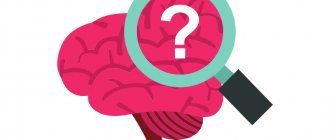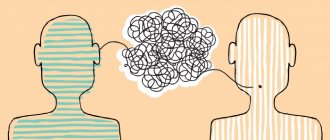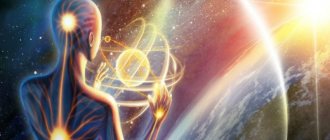Gaius Julius Caesar (July 12-13, 100 BC – March 15, 44 BC)
Julius Caesar is known to everyone. He was a talented commander, the smartest politician, a worthy emperor and a versatile personality. A lot of information about him has been preserved in ancient sources, many artists dedicated their paintings to him, many writers and poets depicted the life of Caesar in their creations. He brought the Roman Empire into its heyday. An interesting fact about him: he could do three things at once - write, talk and watch gladiator fights. The interesting thing is that so far no one has been able to repeat these actions.
How to find and reveal your talent?
Every person has their own talent, but most fail to even find it, let alone realize it. Let's figure out how to consistently solve these problems. First, let's look at the steps you need to take to identify your talent:
- Get rid of obstacles. In the previous section, we identified the main obstacles that prevent people from finding their calling. Obviously, the very first step is to get rid of these interferences.
- Believe in yourself. Although this advice sounds like a cliché, it needs to be done. You need to increase your self-esteem and get rid of doubts in the spirit of “What if I don’t have talents?” Everyone has their own talent.
- Remember your childhood. Among childhood memories you can find many interesting things. Something you liked as a child or teenager may well give you a useful hint. And in general, it is useful to look at your life with the eyes of a carefree child, whose head is not clogged with adult routine.
- Try new things. It's difficult to find your talent if you don't constantly experiment with something new. Fortunately, today it is easier to do this than ever before, because the Internet is full of tips and other useful information.
- Look at the parents. The talents of parents are often passed on to their children. At the same time, parents may well know about their abilities. Perhaps in childhood they drew, played music, or went to a modeling group, but then were forced to give up their hobby.
- Analyze your shortcomings. Very often, problematic aspects of character contain hints of giftedness. For example, excessive perfectionism can seriously interfere with work. And yet there are activities in which it helps to achieve perfection.
- Pay attention to your interests. It happens that a person is interested in a certain topic, watches videos and reads blogs with enthusiasm, but does not even think that he himself could engage in this activity. And it may well turn out that this is where talent is hidden.
Of course, simply finding your talent is not enough. To be able to implement it, you need to work hard, constantly improving your professional level and expanding your knowledge. You also need to remember and follow a few simple rules that are often forgotten:
- never doubt yourself;
- don’t be afraid to step out of your comfort zone;
- constantly learn and develop in your chosen field;
- study information on related topics;
- surround yourself with people who have something to learn from;
- appreciate competitors who motivate development;
- Don’t be afraid to make mistakes and learn to appreciate them.
In addition, it must be taken into account that talent is fully revealed only when a person realizes that he brings benefit to other people with his help. This is an important signal for our brain that gives us a feeling of satisfaction. Thanks to this, talent develops faster and better, allowing a person to realize his potential and protecting him from the emotional burnout that can occur if work ceases to bring joy.
Leonardo di Ser Piero da Vinci (1452-1519)
The 15th century gave the world more than one outstanding talent, but the most famous of them is Leonardo da Vinci. Neither before nor after this genius has history encountered such versatile personalities. At one time he became famous throughout the world not only as a brilliant artist, but also as a scientist, writer, musician, sculptor, inventor, and engineer. Books are written about him, films are made about him, and epics are still told about him. Young Leonardo showed his talents early and went far in time from his era. He surpassed his teacher, the painter Verrocchio, and then created unique masterpieces such as the Mona Lisa, Lady with an Ermine, and Madonna Litta. One of da Vinci's most famous creations is the Vitruvian Man drawing. Many of his works are still fraught with unsolved mysteries and many secrets.
Leo Tolstoy - teacher
Leo Tolstoy and children. Photo: peremeny.ru
In 1859, Tolstoy decided to engage in public education and opened his own school for peasant children in Yasnaya Polyana.
Tolstoy believed that any person could be trained, provided he renounced all coercion. An extremely important innovation in his system was the complete renunciation of violence - the most severe punishment was considered to be exclusion from classes. By the way, they were attended by about 40 children from local villages. Education was free and available to both girls and boys. Lessons started at eight in the morning. The teachers were Moscow and Tula seminarians, as well as the count himself. He strove to turn his students into a friendly family. Attendance was optional—and yet few missed classes. In addition to subjects such as reading, history and mathematics, the curriculum included carpentry and agricultural work.
Lev Nikolaevich was not a strict teacher: he often organized games with the children, climbed gymnastic equipment and enjoyed sliding down ice slides. Once I held a lottery and gave the winner a horse.
Soon about twenty schools using Tolstoy’s methods appeared in the district. And the school in Yasnaya Polyana closed after three years of operation. Lev Nikolaevich returned to great literature.
Johann Sebastian Bach (1685-1750)
Johann Sebastian Bach is one of the greatest composers in history. He created “new music” by abandoning all the traditions of previous times. He went against the rules and showed the world new fusions of sounds, began to use hitherto forbidden intervals, and became a famous master of polyphony. Bach is the first Baroque composer. He gave the world more than 1000 works that were completely new in style.
LiveInternetLiveInternet
The smartest people in history. Their works have shaped our vision of the world. The results of their intellectual work are impressive and motivate them to engage in science.
- Lao Tzu. China (6th century BC)
“He who knows does not speak, he who speaks does not know.” Semi-legendary Chinese thinker, founder of Taoism. Lao Tzu translates to "old child". According to legend, his mother carried Lao Tzu in her womb for 81 years, and he was born from her thigh. La Tzu is considered the author of the key treatise of Taoism, the Tao Te Ching. “Tao” is the path, one of the main categories of Chinese philosophy. “Tao” is wordless, nameless, formless and motionless. No one, not even Lao Tzu, can define “Tao.” In China, the cult of Lao Tzu was formed, who began to be revered as one of the “three pure ones” - the highest deities of the Taoist pantheon.
- Pythagoras. Ancient Greece (570-490 BC)
"Numbers rule the world." Philosopher, mathematician and mystic, creator of the Pythagorean school. According to legend, he had a golden thigh. Herodotus called him "the greatest Hellenic sage." Pythagoras lived in Egypt for 22 years and in Babylon for 12 years. He was admitted there to participate in the sacraments. According to Pythagoras, the basis of things is number; to know the world means to know the numbers that control it. The mathematician probably brought the famous Pythagorean theorem about the square of the hypotenuse from the Babylonians, where it was known 1000 years before him.
- Heraclitus. Ancient Greece (544-483 BC)
"Nature loves to hide." Founder of dialectics. The only work that has survived in fragments is “On Nature”. Heraclitus is credited with the authorship of the catchphrase “Everything flows, everything changes.” The philosopher considered fire to be the origin of all things. Everything came from it and is constantly in a state of change. He led a solitary life. Diogenes Laertius wrote that Heraclitus, “hating people, withdrew and began to live in the mountains, feeding on pasture and herbs.”
- Confucius. China (551 BC - 479 BC)
“If you hate, it means you have been defeated.” An ancient Chinese philosopher, whose ideas became the basis for the development of Confucianism - a philosophical system, worldview, social ethics, and scientific tradition of China. The philosophy of Confucius became popular outside the Middle Kingdom, even in Western Europe. In particular, Nicolas Malebranche and Gottfried Leibniz wrote about Confucianism. A particularly revered book of this teaching is Lun Yu (Conversations and Judgments), compiled by Confucius's students based on the teacher's statements.
- Parmenides. Ancient Greece (515 BC - c. 470 BC)
“Thinking and being are one and the same thing.” One of the founders of metaphysics and the founder of the Eleatic school, mentor of Zeno. Socrates, in Plato's dialogue Theaetetus, said of Parmenides that he was “a thinker of truly extraordinary depth.” Hegel wrote that with Parmenides “philosophy in the proper sense of the word began.” Parmenides believed that the basis of everything lies in Being, apart from which there is nothing. There is no non-existence, and it is even impossible to think and talk about it, since everything that can be thought about already exists, but one cannot think about what does not exist. Being is one and has the shape of a ball.
- Democritus Ancient Greece (c. 460 BC - c. 370 BC)
“To live badly, unreasonably, intemperately does not mean to live badly, but to die slowly.” Democritus was called the "laughing philosopher." He squandered his inheritance on traveling around the world, for which he was even brought to trial. However, he was acquitted when he read an excerpt from his work “The Great World-Building”. Democritus loved to go away from people to cemeteries and think there. They even sent Hippocrates to check his sanity. He not only recognized Democritus as sane, but also called him one of the smartest people. Seneca called Democritus “the most subtle of all thinkers.”
- Plato. Ancient Greece (428 or 427 BC - 348 or 347 BC)
“Man is a wingless creature, bipedal, with flat nails, susceptible to knowledge based on reasoning.” Plato - from the word plato “breadth”. This is what Plato was called by his teacher Socrates. The real name of the philosopher is Aristocles. He was in Persia, Assyria, Phenicia, Babylon, Egypt, and possibly in India. In Athens, Plato founded a philosophical school - the Academy, which existed for almost a thousand years. Twice won the pankration competition. Plato is considered the founder of idealistic philosophy; he developed the doctrine of the soul, political and legal doctrine, and dialectics. He believed in immortality and the transmigration of souls. Plato's most popular works are still his dialogues. In almost all of them, the main character is Socrates.
- Aristotle. Ancient Greece (384 BC. Stagira, Thrace—322 BC)
“For two years a person learns to speak, and then for the rest of his life he learns to remain silent.” Disciple of Plato and tutor of Alexander the Great, founder of the Peripatetic school of philosophy, anatomist. Aristotle's works covered virtually all branches of knowledge. According to Greek biographers, Aristotle suffered from speech impediments, was “short-legged, had small eyes, wore smart clothes and a trimmed beard.” Plato and Aristotle, in fact, laid the foundations of all world philosophy. All formal logic is still based on the teachings of Aristotle.
- Ptolemy. Alexandria (ca. 100 - ca. 170)
“Resist your whims in youth, for in old age you will not be able to correct yourself in order to wean yourself from them.” Late Hellenistic astronomer, astrologer, mathematician, mechanic, optician, music theorist and geographer. He had no equal in astronomy for 1000 years. His classic monograph “Almagest” contains almost all the knowledge about the astronomical science of his time. Ptolemy is the author of the eight-volume work “Guide to Geography”, treatises on mechanics, music, optics and astrology, and invented the astrolabe and quadrant.
- Plotinus. Roman Empire (204/205 - 270)
“Throw it all away.” Not to be confused with Plato. Idealist philosopher, founder of Neoplatonism. He brought Plato's teaching about the ideal to its logical conclusion. The main thing in Neoplatonism is the doctrine of the otherworldliness and super-intelligence of the principles of the universe. According to Plotinus, the beginning and basis of the universe is a certain One - infinite and immaterial. The main life task of a person is “reunion with the One,” which he can accomplish thanks to the presence of his own soul. Plotinus had a significant influence on medieval philosophy, and especially on Renaissance thinkers.
- Prokl. Ancient Greece (412 - 485)
“Every God is the measure of existence.” Neoplatonist philosopher, head of the Platonic Academy. Under Proclus, Neoplatonism reached its final flowering. Alexey Losev put Proclus even higher than the founder of the school of Neoplatonists, Plotinus, and called him a “genius of reason”; with rationality brought “to music, to pathos, to ecstasy.” The works of Proclus, which touched on all aspects of Greek philosophy and science, are characterized by analyticity and systematicity.
- Al Biruni (973-1048)
“If people knew how many favorable opportunities are scattered around and how many wonderful gifts are hidden within themselves, they would forever abandon despondency and laziness.” Al Biruni was one of the most encyclopedically educated scientists. He mastered almost all the sciences of his time. The list of works compiled by his students alone is 60 pages long in small print. Al Biruni is the author of numerous major works on history, geography, philology, astronomy, mathematics, mechanics, geodesy, mineralogy, pharmacology, geology and other sciences. In addition to his native Khorezmian language, Biruni spoke Arabic, Persian, Greek, Latin, Turkic, Syriac, as well as Hebrew, Sanskrit and Hindi.
- Ibn Sina. Samanid State, Abbasid Caliphate (980-1037)
“The less often a hand raises the table cup of wine, the stronger it is in battle and the braver and more skillful it is in business.” Avicenna is the most famous and influential philosopher of the medieval Muslim world, a Persian scientist and doctor, a representative of Eastern Aristotelianism. In total, he wrote more than 450 works in 29 fields of science, of which only 274 have reached us. Avicenna mainly became famous in the field of medicine, writing many treatises on this topic, but also made contributions to other sciences. Thus, he discovered the process of distillation of essential oils, wrote works on astronomy, music theory, mechanics, psychology and philosophy. He also became famous as a poet. He also wrote some scientific works in the form of poems.
- Maimonides (1138-1204)
“Learn to say, ‘I don’t know,’ and that will be progress.” An outstanding Jewish philosopher and theologian - Talmudist, rabbi, doctor and versatile scientist of his era, codifier of the laws of the Torah. Maimonides is recognized as the spiritual leader of religious Jewry both of his generation and of subsequent centuries. He left serious contributions to astronomy, mathematics, physics, and medicine. Maimonides' meaning is best expressed by the popular phrase: "from Moses to Moses there was no such Moses."
- William of Occam. England (1285-1357)
“We must not multiply existing things unnecessarily.” An English philosopher and Franciscan monk, Ockham is considered one of the fathers of modern epistemology and modern philosophy in general, as well as one of the greatest logicians of all time. Ockham's philosophy, especially his discussions about universals, seriously influenced the development of philosophical thought, and the methodological principle, the so-called “Occam's razor,” became one of the most popular philosophical maxims.
- Nikolai Kuzansky. Holy Roman Empire (1401-1464)
“Every person who wants to rise to the knowledge of something must necessarily believe in that without which he cannot rise.” Cardinal of the Roman Catholic Church, the greatest German thinker of the 15th century, philosopher, theologian, encyclopedist, mathematician, church political figure. As a philosopher he stood on the position of Neoplatonism. The basis of philosophy was the idea of the unity of opposites in the One, where all contradictions are leveled. He stood up for religious tolerance, which at that time was not the most popular position, and even recognized Islam as having some truthfulness and right to exist. Cusansky invented a diverging lens for glasses, wrote treatises on astronomy, mathematics, philosophy and theology.
- Marsilio Ficino. Italy (1433-1499)
“Every thing in nature is either a cause directed towards us or an effect coming from us.” Philosopher, humanist, astrologer, founder and head of the Florentine Platonic Academy. One of the leading thinkers of the early Renaissance, the most significant representative of Florentine Platonism. Ficino translated all of Plato's works into Latin. Ficino’s main work is the treatise “Plato’s Theology on the Immortality of the Soul.” He also studied astrology (the treatise “On Life”), which is why he had problems with the clergy. Ficino's works contributed to the revival of Platonism and the fight against scholastic Aristotelianism.
- Leonardo da Vinci. Florentine Republic (1452-1519)
“When I thought I was learning to live, I was learning to die.” "Universal man" of the Western Renaissance, genius. Despite the fact that da Vinci gained his greatest fame as an artist, he considered painting more of a hobby, just like music and the art of table setting. Da Vinci considered engineering to be his main vocation. In it, he truly achieved great heights, anticipating the development of technology for centuries to come. Today in popular culture Leonardo is recognized as the inventor of almost everything that exists. Seriously studying anatomy, da Vinci made thousands of drawings on the structure of the body, ahead of his time by 300 years. In many ways, Leonardo's Anatomy was superior to the famous Gray's Anatomy.
- Paracelsus. Swiss Confederation (1493-1541)
“Everything is poison, and nothing is without poison; Just one dose makes the poison invisible.” Famous alchemist, astrologer and physician of Swiss-German origin, one of the founders of iatrochemistry, medical alchemy. Gave the name to the metal zinc. Paracelsus considered man to be a microcosm in which all the elements of the macrocosm are reflected. In one of his books, “Oracles,” containing 300 pages and many prophecies for the whole world until the end of the 3rd millennium, he made several sensational predictions.
- Nicolaus Copernicus. Poland (1473 -1543)
“I prefer to be content with what I can vouch for.” Polish and Prussian astronomer, mathematician, economist, canon. He initiated the first scientific revolution by developing the hypothesis of a heliocentric system of the world. In addition, Copernicus was one of the first to express the idea of universal gravitation. Copernicus's main work is “On the Rotation of the Celestial Spheres.” Copernicus combined his studies in mathematics and astronomy with work in the field of economic theory and medical practice, which he did on a voluntary basis.
- Isaac Luria. Ottoman Empire (1534-1572)
“...And the light shrank and moved away, leaving a free, unfilled space. And the compression of light around the central point was uniform, So that the empty space took on the shape of a circle, Since such was the contraction of light... And so, a straight ray stretched from the endless light, Descended from top to bottom, into that empty space. The endless light stretched down, descending along the beam, And in that empty space it created all the completely worlds...” Jewish theologian, rabbi, creator of the so-called Lurianic Kabbalah. In Hebrew, Luria is usually abbreviated as Ari ("blessed is his memory"). Lurianic Kabbalah, created by the Ari, is the basis of both Sephardic Kabbalah from the 16th century and Hasidic Kabbalah, which emerged in the 18th century. Almost all modern Kabbalistic schools study Lurianic Kabbalah. In addition to studying Kabbalah, Luria also studied poetry and science. Some believe that in the above poem Luria described the process of the emergence of the Universe from the Big Bang.
- Giordano Bruno. Neopolitan Kingdom (1548-1600)
“The fear of death is worse than death itself.” Italian Dominican monk, pantheist, poet and philosopher. Bruno tried to interpret the ideas of Copernicus, while taking the position of Neoplatonism in the spirit of Renaissance naturalism. Bruno expressed scientific theories that were ahead of their time. About the fact that in the Universe there are many stars similar to the Sun, about the planets of the solar system unknown in his time. Giordano Bruno had an excellent memory and developed mnemonics, memorizing thousands of books, ranging from the Holy Scriptures to Arabic alchemical treatises. He taught the art of mnemonics to Henry III and Elizabeth I.
- John Dee. England (1527-1609)
“By the will of God, I am the Circle, in whose hands are the twelve Kingdoms. Six Thrones of the Breath of Life. The rest are sharp sickles or horns of Death.” Mathematician, geographer, astronomer, alchemist, hermeticist and astrologer. John Dee was one of the most educated people of his time, he had the largest library in England. In 1561, he supplemented and expanded Robert Record's famous book on mathematics, The Fundamentals of the Arts. In 1564 he confirmed his status as a "great magician" by publishing his most famous and ambitious book on the Kabbalah and geometric magic, entitled Monas hieroglyphica. Based on the diaries of John Dee, Gustav Meyrink wrote the novel “The Angel of the Western Window.” Some authors credit John Dee with the authorship of the hoax known as the Voynich manuscript.
- Francis Bacon. England (1561-1626)
"Knowledge is power". Bacon is one of the most prominent universal scientists. Philosopher, politician, historian, founder of English materialism and empiricism. Bacon was the first thinker whose philosophy was based on experimental knowledge. He compiled a code of English laws; he worked on the history of the country during the Tudor dynasty, on the third edition of “Experiments and Instructions.” In his utopian novel “New Atlantis,” Bacon anticipated many discoveries of the future, for example, the creation of submarines, improvement of animal breeds, transmission of light and sound over a distance.
- Johannes Kepler. Holy Roman Empire (1571-1630)
“I prefer the harsh criticism of one intelligent person to the thoughtless approval of the masses.” German mathematician, astronomer, mechanic, optician, discoverer of the laws of motion of the planets of the solar system. Albert Einstein called Kepler "an incomparable man." Indeed, Kepler, almost alone, without any support or understanding, made a lot of discoveries both in astronomy and in mathematics, physics, mechanics and optics, and seriously studied astrology, believing, however, that it was “the stupid daughter of astronomy.”
- Mikhail Sendivogiy. Polish-Lithuanian Commonwealth (1566-1646)
“If you ask who I am: I am a Cosmopolitan, a citizen of the world. If you know me and want to remain kind and noble people, keep my name a secret.” The greatest Polish alchemist of the “Roesnkreuzer era”, who owned the secret of transmutation, the author of many alchemical works. In addition to alchemy, he also practiced medicine and even treated King Sigismund III, for whom he was also a diplomatic advisor. He was a court alchemist for Holy Roman Emperor Ferdinand III. In the book “New Chemical Light...” Sendivogius first described oxygen. Sendivogius's fame also gave rise to folk legends - to this day, in his hometown, his ghost is said to appear in the market square on every New Year's Eve.
- Rene Descartes. France (1569-1650)
“I think, therefore I am.” Descartes is a philosopher, mathematician, mechanic, physicist and physiologist, the creator of analytical geometry and modern algebraic symbolism, the author of the method of radical doubt in philosophy, mechanism in physics, the forerunner of reflexology and the theory of affect. The great Russian physiologist Ivan Pavlov erected a monument-bust to Descartes near his laboratory, considering him his predecessor.
- Pierre Fermat. France (1601-1665)
“Nature always takes the shortest routes.” One of the creators of analytical geometry, mathematical analysis, probability theory and number theory. Pierre Fermat was a lawyer by profession and was a councilor to the parliament in Toulouse. The oldest and most prestigious lyceum in this city is named after the scientist. Fermat was brilliantly educated and knew many languages. Including the ancient ones, on which he even wrote poetry. He is best known for his formulation of Fermat's Last Theorem. It was finally proven only in 1995 by Andrew Wales. The text of the proof contains 129 pages.
- Gottfried Leibniz. Holy Roman Empire (1646-1716)
“The present time is fraught with the future.” Creator of combinatorics and founder of mathematical logic, philosopher, logician, mathematician, mechanic, physicist, lawyer, historian, diplomat, inventor and linguist. Leibniz founded the Berlin Academy of Science and was its first president. Independently of Newton, he created mathematical analysis, described the binary number system, formulated the law of conservation of energy and introduced the concept of “living force” (kinetic energy) into mechanics. Leibniz also invented the adding machine, introduced the concept of “small perceptions” into psychology, and developed the doctrine of unconscious mental life. He also inspired Peter the Great to develop the concept of the Russian Academy of Sciences. The Russian Tsar even awarded Leibniz a prize of 2,000 guilders.
- Isaac Newton. England (1642-1727)
“Genius is the patience of thought concentrated in a certain direction.” Isaac Newton is one of the greatest scientists in history. Physicist, mathematician, mechanic and astronomer, one of the founders of classical physics. The main work is “Mathematical principles of natural philosophy.” In it, he outlined the law of universal gravitation and the three laws of mechanics, which became the basis of classical mechanics. He developed differential and integral calculus, color theory, laid the foundations of modern physical optics, and created many other mathematical and physical theories. Newton was a member of the House of Lords and regularly attended its meetings for many years, but remained silent. One day he finally asked to speak. Everyone expected to hear a grandiose speech, but Newton proclaimed in deathly silence: “Gentlemen, I ask you to close the window, otherwise I might catch a cold!”
- Mikhail Lomonosov. Russia (1711-1765)
“If you do something good with difficulty, the labor will pass, but the good will remain, and if you do something bad with pleasure, the pleasure will pass, but the bad will remain.” The first Russian natural scientist of world significance, encyclopedist, chemist, physicist, astronomer, instrument maker, geographer, metallurgist, geologist, poet, artist, historian. Lomonosov's contribution to various sciences cannot be overestimated. He discovered the presence of an atmosphere on Venus, laid the foundations of the science of glass, developed the molecular-kinetic theory of heat, corpuscular theory, studied electricity, and determined the course of development of the Russian language.
- Immanuel Kant. Prussia (1724-1804)
“A wise man can change his mind; fool - never." The founder of German classical philosophy, one of the greatest thinkers of the 18th century, who had a huge influence on the development of philosophy. Even among punctual Germans, Kant's penchant for discipline and a strict daily routine became the talk of the town. They were synchronizing their watches with Kant walking around Königsberg. In addition to philosophy, Kant was also involved in the natural sciences. He developed a cosmogonic hypothesis of the origin of the solar system from a giant primordial gas nebula, outlined the idea of a genealogical classification of the animal world, put forward the idea of the natural origin of human races, and studied the role of ebbs and flows.
- Johann Goethe. Holy Roman Empire (1749-1832)
“All fathers want their children to achieve what they themselves failed to achieve.” Goethe today is known mainly as a brilliant writer and poet, but he was also a prominent scientist. He stood at the origins of physiognomy, seriously studied chromatics (the science of paints and colors), chemistry, botany and biology. Goethe wrote many works on philosophy, geology, astronomy, literature and art. 14 of the 133 volumes of Goethe's complete works are devoted to scientific topics.
- James Maxwell. Scotland (1831-1879)
“...For the development of science, it is required in any given era not only that people think in general, but that they concentrate their thoughts on that part of the vast field of science that at a given time requires development.” Maxwell is a theoretical physicist and mathematician who laid the foundations of electrodynamics and created the theory of electromagnetic waves and photoelasticity. He invented the method of color photographic printing and was one of the founders of molecular physics. In addition to physics and mathematics, he also made great contributions to astronomy and chemistry.
- Dmitriy Mendeleev. Russia (1834-1907)
“Burning oil is like heating a stove with banknotes.” Russian Da Vinci, the brilliant father of the periodic table of elements, Mendeleev was a versatile scientist and public figure. Thus, he made a significant and invaluable contribution to oil activity. Thanks to Mendeleev, Russia was able not only to abandon the export of kerosene from America, but also to export petroleum products to Europe. Mendeleev was nominated for the Nobel Prize three times, but he never received it.
- Nikola Tesla. Austrian Empire (1856-1943)
“Are you familiar with the expression “You can’t jump above your head”? It's a delusion. A person can do anything." Tesla has been called “the man who invented the 20th century.” Already his early works paved the way for modern electrical engineering; his discoveries were of innovative significance. In the United States, Tesla's fame rivaled that of any inventor or scientist in history or popular culture. Tesla's genius was of a special nature. The inventor always wanted good, but created devices that could destroy humanity. Thus, while studying the resonant vibrations of the Earth, the inventor created a device that actually provokes earthquakes.
- Albert Einstein. Germany (1879-1955)
“What a sad era when it is easier to break an atom than to abandon prejudices.” Einstein is one of the most famous and popular scientists in the public consciousness, a theoretical physicist, one of the founders of modern theoretical physics, winner of the 1921 Nobel Prize in Physics. Einstein is the author of more than 300 scientific works on physics, as well as about 150 books and articles in the field of history and philosophy of science, the author of general and special theories of relativity, laid the foundations of quantum theory and stood at the origins of a new theory of gravity to replace Newton's.
- Carl Gustav Jung. Switzerland (1875-1961)
“Everything that does not suit us in others allows us to understand ourselves.” Jung is a student of Sigmund Freud, who in many ways surpassed his teacher, the founder of analytical psychology. It was Jung who introduced the concepts of introversion and extraversion into psychology to determine the type of personality orientation, developed the associative method of psychotherapy, the doctrine of the collective unconscious, the theory of archetypes, and made a big breakthrough in the theory of dream interpretation.
- Niels Bohr, Denmark (1885-1962)
“If quantum physics doesn’t scare you, then you don’t understand anything about it.” A Nobel Prize winner in physics, Niels has been a member of the Royal Danish Society and its president since 1939. He was an honorary member of the Soviet Academy of Sciences. Bohr is the creator of the first quantum theory of the atom and an active participant in the development of the foundations of quantum mechanics. He also made a significant contribution to the development of the theory of the atomic nucleus and nuclear reactions, processes of interaction of elementary particles with the environment.
- Werner Heisenberg. Germany (1901-1976)
“The first sip from the glass of natural science is taken by an atheist, but God awaits at the bottom of the glass.” Heisenberg is a great theoretical physicist, one of the creators of quantum mechanics. Winner of the Nobel Prize in Physics 1932. Heisenberg laid the foundations of matrix mechanics, formulated the uncertainty relation, and applied the formalism of quantum mechanics to the problems of ferromagnetism and the anomalous Zeeman effect. A number of his works are also devoted to the physics of cosmic rays, the theory of turbulence, and philosophical problems of natural science. During World War II, Heisenberg was the leading theoretician of the German nuclear project.
Katsushika Hokusai (1760-1849)
Katsushika Hokusai also found his place among the most talented people in the world. This is one of the most prominent Chinese engravers and illustrators. During his life, he worked under more than 30 pseudonyms, which surpassed many of his colleagues. By his special unique style, anyone can distinguish his work from the rest. His most famous works are “The Great Wave off Kanagawa” and “Manga”. Modern art historians still call “Manga” an encyclopedia of Chinese life and consider it an invaluable cultural heritage.
In conclusion
Talent is like a torch that illuminates our existence, because the work in which we are talented will always bring pleasure and true joy. Unfortunately, life circumstances sometimes force you to turn away from this light, but, what’s even worse, over time it can fade away. So remember, you can always rekindle that fire. The main thing is to be able to see it. Then it will warm your existence and illuminate the paths of life.
We wish you good luck!
We also recommend reading:
- Storytelling
- Questions to Find Meaning and Happiness
- Fixed Mindset
- Exercises for self-development
- The Myth of Genius
- Talent vs ability. What's more important?
- Two Ways of Thinking by Carol Dweck
- 5 Ways of Thinking
- Vitality Quotient VQ: What is it and why is it important?
- Empathetic intelligence
- 5 ways to develop a talent for happiness
Key words: 1LLL, 1Self-knowledge
Nikola Tesla (1856-1943)
Hardly anyone can imagine life without electricity. For this discovery we should thank the Austrian physicist Nikola Tesla. He made a huge contribution to the development of science. Among the scientist’s achievements are also works on the study of alternating current and ether. One of his most famous experiments was his work studying lightning. The unit of measurement of magnetic induction is named after him. It is thanks to this greatest scientist that people can use the electricity grid.
Nikolai Rimsky-Korsakov - sailor
Nikolai Rimsky-Korsakov in his youth. Photo: ros-kompozitor.ru
Borodin’s colleague in the creative association “The Mighty Handful,” Rimsky-Korsakov was supposed to become a professional naval officer. His interest in service was awakened by his older brother, Voin Andreevich, an outstanding navigator, after whom a group of islands in the Sea of Japan was named.
At the age of 11, Rimsky-Korsakov, known to his family as Nika, learned a star map. He named his canaries after the constellations - Vega, Mizar and Alcor.
Having entered the Naval Training Corps, Nikolai Rimsky-Korsakov swam, rowed, learned naval affairs in practice and became familiar with the structure of ships. One time Nika fell into the water from the mast. “This incident will help him recover from absent-mindedness,” his brother commented on the incident in a letter to his parents.
By the time he graduated from the corps, Rimsky-Korsakov had become seriously interested in music and planned to retire without rank. Voin Andreevich spoke out sharply against such a decision. In his opinion, it was impossible to live on musical earnings in Russia. Nikolai Andreevich did not go against his brother’s will and in 1862 he set sail as a midshipman on the ship “Almaz”. During his two years and seven months of travel, he visited North and South America. However, the impressions of the trip did not outweigh the severe disappointment in the rudeness and harsh morals of the team. In 1873 he retired and devoted himself to music.
It is interesting that the descendants of Nikolai Rimsky-Korsakov returned to the “maritime” profession years later. Thus, the great-grandson and full namesake of the composer is one of the leaders of the Institute of Oceanology of the Russian Academy of Sciences.
Albert Einstein (1879-1955)
Among famous scientific figures, Albert Einstein occupies not the last place. He is an outstanding personality in the world of physics. This German scientist made a huge contribution to the development of theoretical physics and became a Nobel Prize laureate. During his life, Albert Einstein wrote about 300 scientific papers, about a hundred books and articles on scientific topics. He became the founder of many theories, and also foresaw gravitational waves and “quantum teleportation” in advance. Throughout his life, the outstanding physicist was a humanist and did not recognize evil until his death.
What is talent?
Talent is an individual’s innate predisposition to a certain type of activity. The main property of talent is that it is given to a person from birth, and it cannot be developed or created artificially. Therefore, it is often called a gift or giftedness. Talent itself is not an ability. This is only a person’s potential for self-realization , helping him to achieve success with a successful choice of activity.
Talent should not be confused with genius, since it manifests itself only in one area of activity. If a person demonstrates outstanding talent in several unrelated areas, he is considered a genius. But this happens very rarely.
Talent implies not only a predisposition, but also an unconscious craving for a certain type of activity. And if a child shows an increased interest in nature and devotes his free time to studying the world around him, it is likely that in the future he will become an outstanding biologist. In the same way, in early childhood a craving for music, drawing, dancing or other activities may appear.
talent alone . To realize your natural gift, you need to work, train and gain experience - this is the only way to become truly successful. That is why talent is often compared to a diamond, which in itself looks inconspicuous, but after careful cutting it turns into a precious diamond.
Coco Chanel (1883-1971)
Gabrielle Bonheur Chanel is one of the greatest women of the twentieth century, the world's most famous fashion designer, the founder of a new style for women, the founder of the Chanel fashion house. This woman brought something new, hitherto unprecedented, into the world. She dared to show the world something surprisingly bold and elegant. She was the first to “dress a woman in a man’s suit.” Coco Chanel is the first fashion designer to make women's trousers. She also showed the world a women's fitted jacket and a little black dress. Coco Chanel's fashion still remains one of the most elegant and revered. She also invented her own perfume, Chanle No. 5. This fragrance became the most popular in the twentieth century, they were used by Marilyn Monroe, who also starred in their advertising.
Where does talent come from?
One of the main features of human nature is that each of us is a unique individual. Everything about a person is unique: body, brain, nervous system, metabolism, temperament, character, etc. The predisposition to a certain type of activity may depend on several elements or even on one. For example, a musician needs good hearing, and a singer needs not only hearing, but also a strong, beautiful voice.
The basis of talent is made up of two elements:
- successful anatomical structure of a certain organ (for example, vocal cords);
- anatomical and physiological features of the nervous system (for example, absolute pitch or innate empathy).
The anatomical and physiological characteristics of the nervous system are called inclinations. These are genetically predetermined factors that determine the rate of formation of neural connections in the brain and spinal cord, as well as the anatomical features of the structure of the analyzers and some areas of the cerebral cortex. Makings are potential talents that are laid in the early stages of embryo development.
At the same time, the same inclinations can be realized in different ways. For example, if a person has innate absolute pitch and strong vocal cords, he can become a successful singer. And another with the same good hearing, but without a voice, will become a composer. It turns out that initially identical inclinations are realized in the form of two different talents.
Depending on how well the various inclinations coincide, there are 3 levels of development of natural abilities:
- Giftedness. This is the first degree, which often manifests itself in children, but does not always provide sufficient prerequisites for success in a certain field of activity.
- Talent. The second degree of development of natural abilities implies that a person has all the necessary inclinations to achieve success.
- Genius. Genius is usually called the exceptional talent that allows you to become not just successful, but outstanding or even the greatest in the world. People who demonstrate exceptional talent in several areas of activity are also often called geniuses.
Let's look at the difference using musical abilities as an example. Giftedness implies good hearing, but it is not enough for serious success in music. Absolute pitch is already a rare talent (about 1 case per 10 thousand people) and a serious prerequisite for a musical career. Genius implies exceptional ability. For example, Wolfgang Amadeus Mozart is considered a brilliant composer. Obviously, absolute pitch alone is not enough for such recognition.
Salvador Dali (1904-1989)
The list of “The Most Talented People in the World” undoubtedly includes Salvador Dali. During his life, this Spanish genius managed to become a famous artist, an original director, a unique graphic artist, a sculptor and a writer. He is rightfully considered the most outstanding representative of surrealism. Looking at his works of art, you can easily break your head over thoughts of silhouettes, shapes, colors and subjects.
Salvador Dali is one of the unique geniuses that the world has never known. The most famous among his masterpieces are the paintings “Giraffe on Fire”, “Venus with Boxes”, “A Dream Inspired by the Flight of a Bee a Moment Before Awakening” and “The Persistence of Memory”. Salvador Dali wrote several autobiographies, the most famous of which is “The Diary of a Genius.”
Sergei Prokofiev - chess player
Sergei Prokofiev playing chess. Photo: chesshistory.com
The Soviet composer was a chess player of the first category. Within the walls of the Chess Meeting in St. Petersburg, which Prokofiev attended since 1907, he played a draw with the famous German chess player Lasker, lost twice and won once against Capablanca. According to friends, Prokofiev’s game was characterized by attack and pressure, and a non-standard approach to playing the game. Players called his style romantic. He played with inspiration and imagination - but the theoretical basis after the break with the Petrograd chess circle in 1917-1918 was lacking. By the 1940s, Prokofiev's luck began to change, and he lost more and more often.
Nevertheless, he did not give up his hobby. While traveling by correspondence, he played with the director of the Russian Music Publishing House, Gavriil Paichadze. While working on the ballet Romeo and Juliet, he played with himself for several months on a huge board consisting of 12 chessboards.
Marilyn Monroe (1926 - 1962)
Norma Jeane Mortenson is known throughout the world as Marilyn Monroe. During her unfortunately short life, this woman managed to win the hearts of millions and remain in the memory of her fans for many years to come. Marilyn Moreau was a famous film actress and singer. She also earned the title of sex symbol of the 1950s. Films with her participation attract crowds of spectators to the screens even today, fans admire her talents, and many TV stars of our time try to imitate her style of acting and behavior.
Gifted children
Gifted children are found in all countries, although they are not always recognized and developed in a timely manner. Rare people reach the level called genius. Mental talent is a biologically innate quality. It may develop, or it may fade away. It takes willpower, hard work and motivation to achieve for talent to become a genius. And these qualities are not developed in people to the same extent. Family upbringing and social influence play a big role.
And it also happens that a child who was not recognized as gifted from childhood, despite this, later becomes a genius and gives great discoveries to humanity. Thus, school teachers considered Einstein and Mendeleev to be mediocre. P. Gauguin's artistic talent appeared only at the age of 38, and S.T. Aksakova - at 50. Thanks to incredible hard work, they reached creative heights. And along this path they formed as individuals.
Montserrat Caballe (1933 - present)
The Spanish opera singer Montserrat Caballe is considered the most talented person of our time. She became famous thanks to her unusually strong voice and special technique of performing bel canto. Monserat participated in many operas, performing a wide variety of roles. One of the most famous songs is “Barcelona”, performed together with Queen lead singer Freddie Mercury. The opera singer is the winner of many awards and titles. Her talent is recognized all over the world and leaves no connoisseur of beauty indifferent.
Rating
Who are they, outstanding citizens of Russia? The list can be continued endlessly, because every period in the history of our Fatherland has its great people who became famous in different fields of activity. Among the most prominent personalities who, to one degree or another, influenced the course of both Russian and world history, it is worth mentioning the following:
- Kuzma Minin and Dmitry Pozharsky.
- Peter the Great.
- Alexander Suvorov.
- Mikhail Lomonosov.
- Dmitriy Mendeleev.
- Yuri Gagarin.
- Andrey Sakharov.
Jimi Hendrix (1942-1970)
Jimi Hendrix is an original rock musician, guitarist and virtuoso. This is the person who made all the canons of guitar music turn upside down. In 2009, he was officially voted the greatest guitarist of all time.
Even during his lifetime he was called a genius in his field. Jimi Hendrix changed the face of guitar rock and made the guitar sound new. This phenomenal musician was and is admired by many musicians, including Freddie Mercury, Ritchie Blackmore and Kurt Cobain.
Giftedness and its role in human life
In psychology, there is no consensus on what giftedness is, and most often this concept is used in pedagogy. There, giftedness is considered as a complex of personality qualities that contributes to the successful acquisition of knowledge and the development of skills in educational activities.
In psychology, there are several points of view on the essence of this concept, but most often giftedness is associated with cognitive abilities: attention, memory, thinking, imagination and creativity. The concept of “giftedness” thus includes the following individual characteristics:
- observation and high level of concentration;
- the ability to quickly and often spontaneously remember diverse information;
- free access to information stored in memory and, as a result, associative thinking;
- flexible thinking, capable of operating with concepts and categories from different fields of knowledge;
- high level of logical thinking;
- developed imaginative thinking and imagination;
- the ability to think original, creatively and find non-standard solutions to problems.
Thus, giftedness provides a person with the opportunity to master various types of activities, but this opportunity is potential, since special abilities are also necessary for success. Although, given that giftedness presupposes a penchant for creativity and significant general activity, a person with a high level of this characteristic will always find an area of self-realization and an area where he can achieve success. And a number of psychologists also identify special talent associated with special abilities.
Worldwide fame of the great chemist
In 1869, at the age of 35, Dmitry Mendeleev made a discovery that made him famous throughout the world. We are talking about the Periodic Table of Chemical Elements. It became the basis for all modern chemistry. Attempts to systematize elements by properties and atomic weight were made before Mendeleev, but he was the first who managed to clearly formulate the pattern existing between them.
The periodic table is not the scientist’s only achievement. He wrote many fundamental works on chemistry and initiated the creation of the Chamber of Weights and Measures in St. Petersburg. D.I. Mendeleev was a holder of eight honorary orders of the Russian Empire and foreign countries. He was awarded a doctorate from the Turin Academy of Sciences, Oxford, Cambridge, Priston, Edinburgh and Göttingen universities. Mendeleev's scientific authority was so high that he was nominated for the Nobel Prize three times. Unfortunately, the winners of this prestigious international award were different scientists each time. However, this fact does not in any way diminish the merits of the famous chemist to the Fatherland.
Minin and Pozharsky
The outstanding citizen of Russia Kuzma Minin and his equally famous contemporary Prince Dmitry Pozharsky went down in history as the liberators of Russian lands from Polish invaders. At the beginning of the 17th century, the Time of Troubles began in the Russian state. The crisis, which engulfed many areas of life, was aggravated by the presence of impostors on the capital’s throne. In Moscow, Smolensk and a number of other cities, the Polish gentry ruled in full swing, and the western borders of the country were occupied by Swedish troops.
In order to drive out foreign invaders from Russian lands and liberate the country, the clergy called on the population to create a people's militia and liberate the capital from the Poles. The Novgorod zemstvo elder Kuzma Minin (Sukhoruk), who, although not of noble origin, responded to the call, but was a true patriot of his Motherland. In a short time, he managed to gather an army from the residents of Nizhny Novgorod. Prince Dmitry Pozharsky from the Rurik family agreed to head it.
Gradually, residents of surrounding cities, dissatisfied with the dominance of the Polish gentry in Moscow, began to join the people's militia of Nizhny Novgorod. By the fall of 1612, the army of Minin and Pozharsky numbered about 10 thousand people. At the beginning of November 1612, the Nizhny Novgorod militia managed to expel the Poles from the capital and force them to sign an act of surrender. The successful operation was made possible thanks to the skillful actions of Minin and Pozharsky. In 1818, the memory of the heroic liberators of Moscow was immortalized by the sculptor I. Martos in a monument erected on Red Square.











